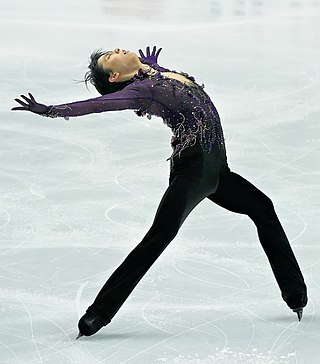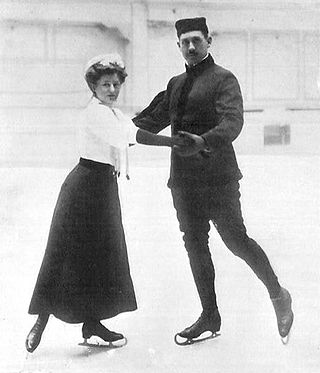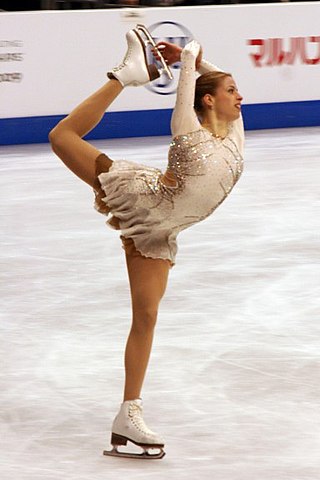Gallery
Single
- An inside spread eagle (Mao Asada)
- An outside spread eagle
(Andrei Griazev) - An outside spread eagle
(Caroline Zhang) - An outside spread eagle
(Yuzuru Hanyu)
Pairs
Ice dancing
Synchronized skating
- Outside spread eagles
(The Hockettes)
| Figure skating element | |
|---|---|
| Element name | Spread eagle |
| Element type | Moves in the field |
The spread eagle is one of the moves in the field in the sport of figure skating, in which a skater glides on both feet, the toes turned out to the sides, heels facing each other. It can be performed on either the inside or outside edges. It is commonly used as an entrance to jumps, adding to the difficulty level of that jump under the Code of Points. It is most commonly used an entrance to an Axel jump.

Figure skating is a sport in which individuals, pairs, or groups perform on figure skates on ice. It was the first winter sport to be included in the Olympic Games, with its introduction occurring at the 1908 Olympics in London. The Olympic disciplines are men's singles, women's singles, pair skating, and ice dance; the four individual disciplines are also combined into a team event, which was first included in the Winter Olympics in 2014. The non-Olympic disciplines include synchronized skating, Theater on Ice, and four skating. From intermediate through senior-level competition, skaters generally perform two programs, which, depending on the discipline, may include spins, jumps, moves in the field, lifts, throw jumps, death spirals, and other elements or moves.
Figure skating jumps are an element of three competitive figure skating disciplines: men's singles, women's singles, and pair skating – but not ice dancing. Jumping in figure skating is "relatively recent". They were originally individual compulsory figures, and sometimes special figures; many jumps were named after the skaters who invented them or from the figures from which they were developed. It was not until the early part of the 20th century, well after the establishment of organized skating competitions, when jumps with the potential of being completed with multiple revolutions were invented and when jumps were formally categorized. In the 1920s Austrian skaters began to perform the first double jumps in practice. Skaters experimented with jumps, and by the end of the period, the modern repertoire of jumps had been developed. Jumps did not have a major role in free skating programs during international competitions until the 1930s. During the post-war period and into the 1950s and early 1960s, triple jumps became more common for both male and female skaters, and a full repertoire of two-revolution jumps had been fully developed. In the 1980s men were expected to complete four or five difficult triple jumps, and women had to perform the easier triples. By the 1990s, after compulsory figures were removed from competitions, multi-revolution jumps became more important in figure skating.

Spins are an element in figure skating in which the skater rotates, centered on a single point on the ice, while holding one or more body positions. They are performed by all disciplines of the sport, single skating, pair skating, and ice dance, and are a required element in most figure skating competitions. As The New York Times says, "While jumps look like sport, spins look more like art. While jumps provide the suspense, spins provide the scenery, but there is so much more to the scenery than most viewers have time or means to grasp". According to world champion and figure skating commentator Scott Hamilton, spins are often used "as breathing points or transitions to bigger things".
The Salchow jump is an edge jump in figure skating. It was named after its inventor, Ulrich Salchow, in 1909. The Salchow is accomplished with a takeoff from the back inside edge of one foot and a landing on the back outside edge of the opposite foot. It is "usually the first jump that skaters learn to double, and the first or second to triple". Timing is critical because both the takeoff and landing must be on the backward edge. A Salchow is deemed cheated if the skate blade starts to turn forward before the takeoff, or if it has not turned completely backward when the skater lands back on the ice.
The Lutz is a figure skating jump, named after Alois Lutz, an Austrian skater who performed it in 1913. It is a toepick-assisted jump with an entrance from a back outside edge and landing on the back outside edge of the opposite foot. It is the second-most difficult jump in figure skating and "probably the second-most famous jump after the Axel".
The toe loop jump is the simplest jump in the sport of figure skating. It was invented in the 1920s by American professional figure skater Bruce Mapes. The toe loop is accomplished with a forward approach on the inside edge of the blade; the skater then switches to a backward-facing position before their takeoff, which is accomplished from the skater's right back outside edge and left toepick. The jump is exited from the back outside edge of the same foot. It is often added to more difficult jumps during combinations and is the most common second jump performed in combinations. It is also the most commonly attempted jump.
The flip jump is a figure skating jump.
The loop jump is an edge jump in the sport of figure skating. The skater executes it by taking off from the back outside edge of the skating foot, turning one rotation in the air, and landing on the back outside edge of the same foot. It is often performed as the second jump in a combination.
A spiral is an element in figure skating where the skater glides on one foot while raising the free leg above hip level. It is akin to the arabesque in ballet.
A three-turn is a figure skating element which involves both a change in direction and a change in edge. For example, when a skater executes a forward outside three-turn, the skater begins on a forward outside edge and finishes on a backwards inside edge. There are eight three-turns in all; one for each possible combination of direction, skating foot, and edge.
An Ina Bauer is a "moves in the field" element in figure skating in which a skater skates on two parallel blades. One foot is on a forward edge and the other leg is on a backwards and different parallel edge. The forward leg is bent slightly and the trailing leg is straight. If the leading leg is on the inside edge, the move is known as an inside ina bauer. If the skater is on the outside edge, it is known as an outside ina bauer. Many skaters bend backwards while performing this move, although this is not required. The most flexible skaters can bend over almost completely backwards. When performed this way, the move is called a layback Ina Bauer, after the layback position.
A choctaw turn is a turn in figure skating that involves both a change of foot and a change of edge and lobe. Choctaws are the two-foot equivalents of rockers and counters, in the same way that mohawk turns are the two-foot equivalents of three turns and brackets.

A split is a physical position in which the legs are in line with each other and extended in opposite directions. Splits are commonly performed in various athletic activities, including dance, figure skating, gymnastics, contortionism, synchronized swimming, cheerleading, martial arts, aerial arts and yoga as exercise, where a front split is named Hanumanasana and a side split is named Samakonasana. A person who has assumed a split position is said to be "in a split", or "doing the splits", or "doing a split".

Pair skating is a figure skating discipline defined by the International Skating Union (ISU) as "the skating of two persons in unison who perform their movements in such harmony with each other as to give the impression of genuine Pair Skating as compared with independent Single Skating". The ISU also states that a pairs team consists of "one Woman and one Man". Pair skating, along with men's and women's single skating, has been an Olympic discipline since figure skating, the oldest Winter Olympic sport, was introduced at the 1908 Summer Olympics in London. The ISU World Figure Skating Championships introduced pair skating in 1908.

A hydroblade is a figure skating edge move or connecting step in which a skater glides on a deep edge with the body stretched in a very low position, almost touching the ice. Several variations in position are possible, but one commonly performed by singles skaters is on a back inside edge with the knee of the skating leg deeply bent, the free leg crossed behind and extended outside the circle, and the upper body leaning into the circle with two, one, or no hands skimming the ice.
The following is a glossary of figure skating terms, sorted alphabetically.

The death spiral is a figure skating term used to describe a spin involving two partners in the discipline of pair skating, in which one partner lowers the other partner while the partner getting close to the ice arches backward on one foot. It was created by German professional skater Charlotte Oelschlägel and her husband Curt Newmann in the 1920s. Suzanne Morrow and Wallace Diestelmeyer from Canada were the first pair team to perform the death spiral one-handed, at the 1948 Olympic Games. In the 1960s, Soviet pair team Liudmila Belousova and Oleg Protopopov created three death spirals: "the backward-inside, forward-inside and forward-outside death spirals, which they originally named the Cosmic Spiral, Life Spiral and Love Spiral, respectively". The International Skating Union (ISU), the governing body that oversees figure skating, allows for variations of arm holds and pivot positions. Senior pair skating teams must perform different types of death spirals in their short programs and free skating programs.

Single skating is a discipline of figure skating in which male and female skaters compete individually. Men's singles and women's singles are governed by the International Skating Union (ISU). Figure skating is the oldest winter sport contested at the Olympics, with men's and women's single skating appearing as two of the four figure skating events at the London Games in 1908.
British Ice Skating is the national governing body of ice skating within the United Kingdom. Formed in 1879, it is responsible for overseeing all disciplines of ice skating: figure skating ; synchronised skating; and speed skating.
The Axel jump or Axel Paulsen jump, named after its inventor, Norwegian figure skater Axel Paulsen, is an edge jump performed in figure skating. It is the sport's oldest and most difficult jump, and the only basic jump in competition with a forward take-off, which makes it the easiest to identify. A double or triple Axel is required in both the short program and the free skating segment for junior and senior single skaters in all events sanctioned by the International Skating Union (ISU).